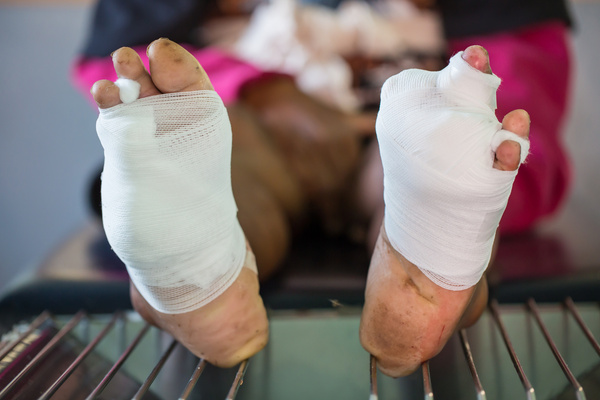How To Care for Diabetic Foot Wound
Type II diabetes is an increasingly common condition in the United States. According to the CDC, more than 33 million Americans have diabetes – representing roughly 10 percent of the population. Type II diabetics are more prone to foot wounds and ulcers due to inadequate foot circulation.
The American Podiatric Medical Association reports that 15 percent of people with diabetes will develop a foot ulcer. Without adequate circulation, foot ulcers or wounds cannot heal – resulting in diabetes being the leading cause of non-traumatic, lower-extremity amputations in the US.
Learning how to care for a diabetic foot wound is of the utmost importance. Even small wounds can become infected, leading to sepsis, bone infections, and more.
What is a diabetic foot ulcer?
A diabetic foot ulcer is an open wound or sore commonly located on the sole of the foot. Diabetic foot ulcers differ from regular foot ulcers in their cause and prognosis. While a cut, scrape, burn, or ulceration is of little concern to a nondiabetic individual, in diabetics, the healing process is slowed substantially – creating a chance for infection.
Why is foot care important for diabetics?
Prolonged high blood sugar levels – indicative of diabetes – gradually damage the blood vessels and nerves in the feet. Nerve damage, or neuropathy, prevents people with diabetes from reacting normally to pain. If they get a splinter, ingrown toenail, or their foot rubs against their shoe, they won't notice. The issue will continue to worsen until it becomes an ulcer or major wound.
Moreover, the lack of blood supply and elevated sugar levels prevent the body from fighting the infection. Blood supplies nutrients needed to repair the damage and bring white blood cells to the frontline to combat the bacteria or fungus.
Without these key systems, infections last longer and cause more severe damage – that's why a proactive approach to foot care is so important.
How to care for diabetic foot wound
A doctor or podiatrist should treat diabetic foot wounds. We'll explain what they will do below. Diabetic patients should be proactive when they discover a wound by following these key steps:
Always wash your hands before touching or cleaning the wound using soap and warm water (or an antiseptic cleaner). You do not want to introduce bacteria to the wound site.
Clean the foot thoroughly using soap and warm water, followed by an antibacterial solution. If you use soap, ensure it isn't too sudsy – this can clog the pores, increasing bacterial growth.
Dry the affected area with a clean towel. Remove all moisture. Be careful not to pull on the skin surrounding the wound; this can have dirt particles in the dried-off blood and secretions.
Apply a dry non-stick dressing and sterile gauze, and secure with tape or adhesive strips.
Monitor your blood glucose levels to improve the healing time and stop infections.
Clean the wound daily, applying fresh bandages.
How to treat a diabetic foot wound
If you have diabetes, you should always consult your doctor or podiatrist about any wound – even if minor. Before consulting a medical professional, remember to clean and bandage the wound (following the above steps).
Your podiatrist/doctor will perform a thorough wound assessment. This may include:
Debridement. Dead tissue will be removed from the edges of the wound, and it will be carefully cleaned. Debridement should only be carried out by a trained professional.
Topical antibiotic. A topical antibiotic may be applied to prevent infection and speed up wound healing.
Off-loading. Because pressure is a key cause of ulcers in a person with diabetes, removing pressure can help speed healing. Using a removable cast, special footwear, or a walker may be advised.
Hyperbaric oxygen therapy. When blood supply is impaired and a wound is severe, high levels of concentrated oxygen may be advised to improve blood supply and oxygen delivery to the wound.
In addition to these treatments, your podiatrist will advise on how to care for your wound at home. Moist wound healing, for instance, heals wounds three to five times faster than otherwise. Your podiatrist may, therefore, prescribe an ointment and sensitive plaster to help speed up the healing process.
Diabetic foot wound prevention
Preventing wounds should be a priority for people with diabetes. Nothing is more important than managing your diabetes. Not only will it reduce the risk of foot infections, but it will also prevent further damage to your blood vessels and nerves in your feet.
Other wound prevention measures include:
Eating a healthy diet
Avoiding alcohol and tobacco use
Reducing pressure on the feet
Exercising regularly
Washing your feet daily
Treating corns and calluses gently
Trimming toenails straight across


